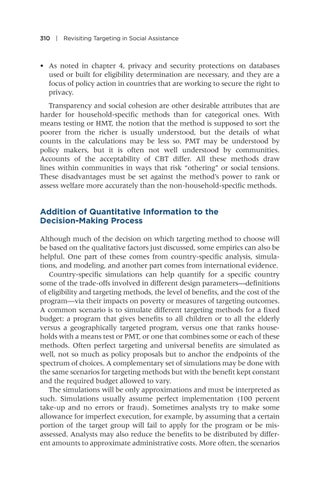310 | Revisiting Targeting in Social Assistance
• As noted in chapter 4, privacy and security protections on databases used or built for eligibility determination are necessary, and they are a focus of policy action in countries that are working to secure the right to privacy. Transparency and social cohesion are other desirable attributes that are harder for household-specific methods than for categorical ones. With means testing or HMT, the notion that the method is supposed to sort the poorer from the richer is usually understood, but the details of what counts in the calculations may be less so. PMT may be understood by policy makers, but it is often not well understood by communities. Accounts of the acceptability of CBT differ. All these methods draw lines within communities in ways that risk “othering” or social tensions. These disadvantages must be set against the method’s power to rank or assess welfare more accurately than the non-household-specific methods.
Addition of Quantitative Information to the Decision-Making Process Although much of the decision on which targeting method to choose will be based on the qualitative factors just discussed, some empirics can also be helpful. One part of these comes from country-specific analysis, simulations, and modeling, and another part comes from international evidence. Country-specific simulations can help quantify for a specific country some of the trade-offs involved in different design parameters—definitions of eligibility and targeting methods, the level of benefits, and the cost of the program—via their impacts on poverty or measures of targeting outcomes. A common scenario is to simulate different targeting methods for a fixed budget: a program that gives benefits to all children or to all the elderly versus a geographically targeted program, versus one that ranks households with a means test or PMT, or one that combines some or each of these methods. Often perfect targeting and universal benefits are simulated as well, not so much as policy proposals but to anchor the endpoints of the spectrum of choices. A complementary set of simulations may be done with the same scenarios for targeting methods but with the benefit kept constant and the required budget allowed to vary. The simulations will be only approximations and must be interpreted as such. Simulations usually assume perfect implementation (100 percent take-up and no errors or fraud). Sometimes analysts try to make some allowance for imperfect execution, for example, by assuming that a certain portion of the target group will fail to apply for the program or be misassessed. Analysts may also reduce the benefits to be distributed by different amounts to approximate administrative costs. More often, the scenarios


